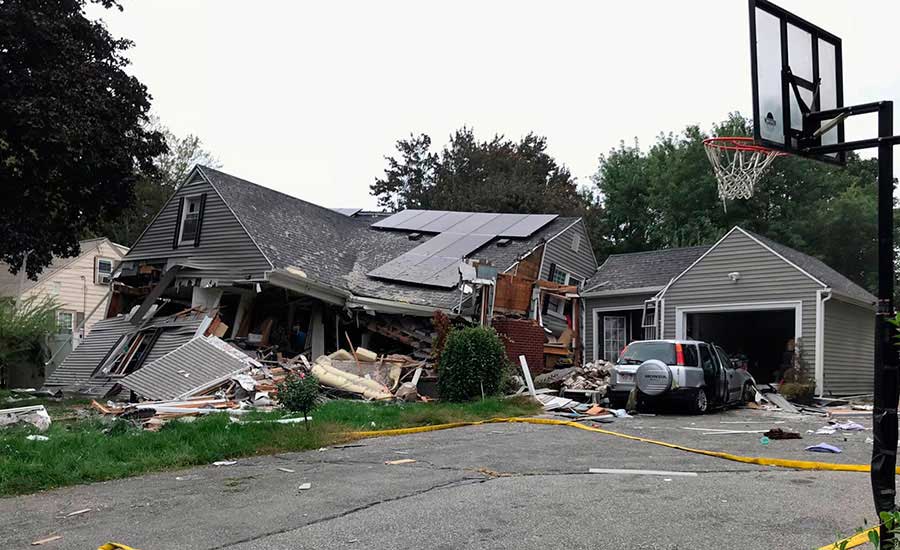Too much pressure surging through a natural gas pipeline caused a massive explosion in Massachusetts that killed one person, injured several others and set as many as 80 buildings ablaze on Sept. 13, according to federal officials.
The National Transportation Safety Board (NTSB), which is investigating the accident along with other federal and state agencies, said while it was unclear why gas was flowing into homes at unusually high rates, NTSB investigators found gas pressure sensor equipment on a decommissioned gas line, Robert Sumwalt, the agency’s chairman, said during a Sept. 16 press briefing. He said, “The investigation will answer two questions: ‘What affect if any did this have on the overpressure situation?’ And secondly, ‘why was this sensor connected to a gas line that was being placed out of service?’”
The news came as residents began returning to their Lawrence, Andover and North Andover homes in the state’s Merrimack Valley. While utilities restored electricity cut off to approximately 18,000 customers after the explosion to prevent further fires, 8,500 homes could be without gas for weeks as crews work to restore service. Columbia Gas also announced a plan to accelerate the already-planed overhaul of the affected 48-mile iron and steel gas system in the three affected communities with modern plastic distribution mains and service lines. Columbia Gas serves about 50,000 customers in the area.
Prior to the explosion, a Columbia subcontractor had capped a pressure line seven blocks from the pressure sensor equipment on the decommissioned line, Sumwalt said. He said a pipeline that’s capped on both end limits the line’s gas flow and causes the pressure sensor to "open up the regulator," allowing more gas to flow. He said his team needs to determine if there was a "relationship between the construction on [Sept. 13] and this event?’”
A spokesman for Columbia declined to elaborate on the work that was being performed just before the explosion.
Sumwalt said Columbia Gas reported the increased pressure to the NTSB, but the exact moment the explosion happened is still unclear as is how much extra gas flowed through the lines. NTSB will excavate and inspect the remaining pressure regulators controlling the pipeline’s flow. While the regulators should ensure that gas enters homes at one-half pounds per square inch, Sumwalt says, pressure passing through a completely open regulator valve would typically be at much higher 75 PSI before decreasing as it traveled farther from the regulator. “What [PSI] it entered at some house way down stream,” he says, “we don’t know that right now.”
Investigators will continue to collect physical evidence from the disaster site and interview the involved parties during the next several days. NTSB plans to interview the pipeline controller and review Columbia Gas’s response to the pressure increase, including the company’s procedures for handling such events, Sumwalt said. Investigators will also recreate the timeline beginning three weeks prior to the explosion, taking note of pipeline tests, repairs and inspections, as well as Columbia Gas’s response to reports of customers complaining about gas smells in the area. Columbia Gas’s overall safety record, training protocols, procedures and emergency planning will also be reviewed.
Sumwalk says NTSB’s investigation could take as long as two years. In the meantime, he says, NTSB will issue “urgent safety recommendations” if pressing issues become evident during the investigation.
Columbia officials say the company is cooperating with the investigation and that they take full responsibility for the disaster. The company has been widely criticized for a slow and inefficient response to the explosion. Gov. Charlie Baker removed Columbia Gas from its role leading recovery efforts on Sept. 14, the same day he issued a state of emergency. Baker put energy utility Eversource in charge of the effort.
The day after the explosion, Columbia’s statement that in part apologized for a the “inconvenience” to customers, was seen as insensitive. “We know this has damaged the confidence and trust in our company and what we do,” Joe Hamrock, chief executive of NiSource, which owns Columbia Gas, later told reporters on Sept. 16. “Our full commitment is restoring that trust and that confidence.”
Columbia hopes to begin construction on the new gas system as soon as possible. Ken Stammen, a spokesman for NiSource, Columbia Gas' parent company, told ENR that its goal is to complete the work before the winter heating season. “We want to be aggressive in our schedule but can’t give a precise estimate because the plan is still being developed with stake holders in Massachusetts,” said Stammen, noting the project’s scope includes 8,600 service lines installed across the three towns.
The approximately 1-inch diameter plastic mainlines and customer-service lines will replace outdated cast-iron and steel pipes, some of which are a century old. Stammen said Columbia is midway through a 20-year-plus program to upgrade its pipelines street-by-street and neighborhood-by-neighborhood across the seven states they operate. But Stammen says that “in light of" the explosion, Columbia decided “to go into all three communities and do a whole makeover of the system.”
He said installing the system all at once is “unprecedented” for Columbia. Stammen acknowledged that Columbia’s effort to replace the pipeline is further challenged by intense scrutiny being placed on the company. “We expect the community and all local stakeholders to watch us closely," he said, "as they should."



